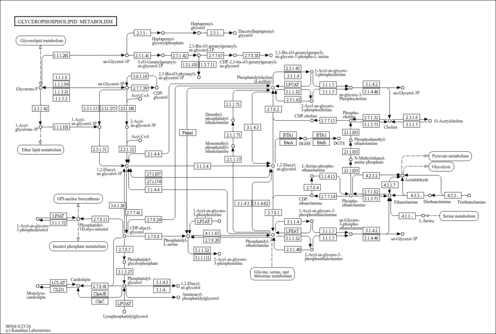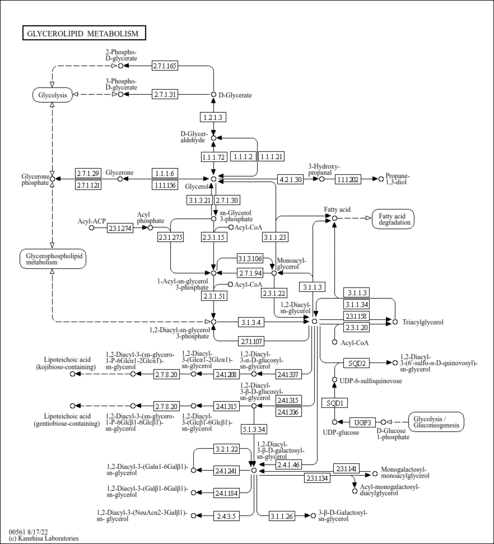| Record Information |
|---|
| Version | 1.0 |
|---|
| Created at | 2020-03-30 18:14:25 UTC |
|---|
| Updated at | 2020-12-07 19:08:06 UTC |
|---|
| CannabisDB ID | CDB001259 |
|---|
| Secondary Accession Numbers | Not Available |
|---|
| Cannabis Compound Identification |
|---|
| Common Name | LysoPA(16:0/0:0) |
|---|
| Description | LysoPA(16:0/0:0) is a lysophosphatidic acid. It is a glycerophospholipid in which a phosphate moiety occupies a glycerol substitution site. Lysophosphatidic acids can have different combinations of fatty acids of varying lengths and saturation attached at the C-1 (sn-1) or C-2 (sn-2) position. Fatty acids containing 16 and 18 carbons are the most common.LysoPA(16:0/0:0), in particular, consists of one hexadecanoyl chain. Lysophosphatidic acid is the simplest possible glycerophospholipid. It is the biosynthetic precursor of phosphatidic acid. Although it is present at very low levels only in animal tissues, it is extremely important biologically, influencing many biochemical processes. This compound is expected to be in Cannabis as all living plants are known to produce and metabolize it. |
|---|
| Structure | |
|---|
| Synonyms | | Value | Source |
|---|
| 1-Hexadecanoyl-sn-glycero-3-phosphate | ChEBI | | 1-Hexadecanoyl-sn-glycero-3-phosphoric acid | Generator | | 1-Palmitoylglycerol 3-phosphoric acid | HMDB | | 1-Palmitoyl-sn-glycerol 3-phosphate | HMDB | | PLPA | HMDB | | 1-Palmitoyl-lysophosphatidic acid | HMDB | | 1-Palmitoyl-lysophosphatidic acid, (R)-isomer | HMDB | | 1-Palmitoyl-rac-glycerol 3-phosphate | HMDB | | 1-Palmitoyl-lysophosphatidic acid, sodium salt, (R)-isomer | HMDB | | Lysophosphatidic acid(16:0) | HMDB | | 1-Palmitoyl-glycero-3-phosphate | HMDB | | 1-Hexadecanoyl-phosphatidic acid | HMDB | | LPA(16:0) | HMDB | | LPA(16:0/0:0) | HMDB | | 1-Hexadecanoyl-glycero-3-phosphate | HMDB | | Lysophosphatidic acid(16:0/0:0) | HMDB |
|
|---|
| Chemical Formula | C19H39O7P |
|---|
| Average Molecular Weight | 410.48 |
|---|
| Monoisotopic Molecular Weight | 410.2433 |
|---|
| IUPAC Name | [3-(hexadecanoyloxy)-2-hydroxypropoxy]phosphonic acid |
|---|
| Traditional Name | PLPA |
|---|
| CAS Registry Number | Not Available |
|---|
| SMILES | CCCCCCCCCCCCCCCC(=O)OCC(O)COP(O)(O)=O |
|---|
| InChI Identifier | InChI=1S/C19H39O7P/c1-2-3-4-5-6-7-8-9-10-11-12-13-14-15-19(21)25-16-18(20)17-26-27(22,23)24/h18,20H,2-17H2,1H3,(H2,22,23,24) |
|---|
| InChI Key | YNDYKPRNFWPPFU-UHFFFAOYSA-N |
|---|
| Chemical Taxonomy |
|---|
| Description | Belongs to the class of organic compounds known as 1-acylglycerol-3-phosphates. These are lysophosphatidic acids where the glycerol is esterified with a fatty acid at O-1 position. |
|---|
| Kingdom | Organic compounds |
|---|
| Super Class | Lipids and lipid-like molecules |
|---|
| Class | Glycerophospholipids |
|---|
| Sub Class | Glycerophosphates |
|---|
| Direct Parent | 1-acylglycerol-3-phosphates |
|---|
| Alternative Parents | |
|---|
| Substituents | - 1-acylglycerol-3-phosphate
- Fatty acid ester
- Monoalkyl phosphate
- Fatty acyl
- Alkyl phosphate
- Phosphoric acid ester
- Organic phosphoric acid derivative
- Carboxylic acid ester
- Secondary alcohol
- Carboxylic acid derivative
- Monocarboxylic acid or derivatives
- Hydrocarbon derivative
- Organic oxide
- Organic oxygen compound
- Carbonyl group
- Alcohol
- Organooxygen compound
- Aliphatic acyclic compound
|
|---|
| Molecular Framework | Aliphatic acyclic compounds |
|---|
| External Descriptors | |
|---|
| Ontology |
|---|
|
| Physiological effect | Organoleptic effect: |
|---|
| Disposition | Route of exposure: Source: Biological location: |
|---|
| Role | Industrial application: Biological role: |
|---|
| Physical Properties |
|---|
| State | Solid |
|---|
| Experimental Properties | | Property | Value | Reference |
|---|
| Melting Point | Not Available | Not Available | | Boiling Point | Not Available | Not Available | | Water Solubility | Not Available | Not Available | | logP | Not Available | Not Available |
|
|---|
| Predicted Properties | [] |
|---|
| Spectra |
|---|
| EI-MS/GC-MS | | Type | Description | Splash Key | View |
|---|
| Predicted GC-MS | LysoPA(16:0/0:0), 1 TMS, Predicted GC-MS Spectrum - 70eV, Positive | splash10-02n9-5940100000-a5ca92d33fddeb085287 | Spectrum | | Predicted GC-MS | LysoPA(16:0/0:0), non-derivatized, Predicted GC-MS Spectrum - 70eV, Positive | Not Available | Spectrum |
|
|---|
| MS/MS | | Type | Description | Splash Key | View |
|---|
| MS/MS | LC-MS/MS Spectrum - NA , positive | splash10-03di-0549600000-25838221a69792238ab5 | 2020-07-21 | View Spectrum | | Predicted MS/MS | Predicted LC-MS/MS Spectrum - 10V, Positive | splash10-08fr-2986700000-f3b30f5c39843042fd11 | 2015-09-15 | View Spectrum | | Predicted MS/MS | Predicted LC-MS/MS Spectrum - 20V, Positive | splash10-0a4s-3942000000-0e96d3c410d5f67cbc44 | 2015-09-15 | View Spectrum | | Predicted MS/MS | Predicted LC-MS/MS Spectrum - 40V, Positive | splash10-0a4s-6930000000-8e619c799b8a218b3a05 | 2015-09-15 | View Spectrum | | Predicted MS/MS | Predicted LC-MS/MS Spectrum - 10V, Negative | splash10-0a4r-4190300000-bb83e3f01055cbe6102f | 2015-09-15 | View Spectrum | | Predicted MS/MS | Predicted LC-MS/MS Spectrum - 20V, Negative | splash10-004i-9050000000-de299cedb3cf89da4492 | 2015-09-15 | View Spectrum | | Predicted MS/MS | Predicted LC-MS/MS Spectrum - 40V, Negative | splash10-004i-9000000000-f3fc94f808e80bf00353 | 2015-09-15 | View Spectrum | | Predicted MS/MS | Predicted LC-MS/MS Spectrum - 10V, Negative | splash10-0a4i-0000900000-97431642e54a4a707394 | 2021-09-24 | View Spectrum | | Predicted MS/MS | Predicted LC-MS/MS Spectrum - 20V, Negative | splash10-0a4i-0000900000-97431642e54a4a707394 | 2021-09-24 | View Spectrum | | Predicted MS/MS | Predicted LC-MS/MS Spectrum - 40V, Negative | splash10-0pb9-2951500000-d6189b2a977487b10d88 | 2021-09-24 | View Spectrum | | Predicted MS/MS | Predicted LC-MS/MS Spectrum - 10V, Positive | splash10-03di-0000900000-61bb60154e9d7308c06d | 2021-09-24 | View Spectrum | | Predicted MS/MS | Predicted LC-MS/MS Spectrum - 20V, Positive | splash10-03di-0000900000-61bb60154e9d7308c06d | 2021-09-24 | View Spectrum | | Predicted MS/MS | Predicted LC-MS/MS Spectrum - 40V, Positive | splash10-00du-0955100000-a47b051136d1c4973480 | 2021-09-24 | View Spectrum |
|
|---|
| NMR | Not Available |
|---|
| Pathways |
|---|
| Pathways | | Name | SMPDB/Pathwhiz | KEGG | | Phospholipid Biosynthesis |    |  | | Glycerolipid Metabolism |    |  | | Glycerol Kinase Deficiency |    | Not Available | | D-glyceric acidura |    | Not Available | | Familial lipoprotein lipase deficiency |    | Not Available |
|
|---|
| Protein Targets |
|---|
| Enzymes | |
|---|
| Transporters | Not Available |
|---|
| Metal Bindings | |
| Ectonucleotide pyrophosphatase/phosphodiesterase family member 2 | ENPP2 | 8q24.1 | Q13822 | details | | Diacylglycerol kinase alpha | DGKA | 12q13.3 | P23743 | details | | Diacylglycerol kinase beta | DGKB | 7p21.2 | Q9Y6T7 | details | | Lysophosphatidylcholine acyltransferase 1 | LPCAT1 | 5p15.33 | Q8NF37 | details | | Lysophosphatidylcholine acyltransferase 2 | LPCAT2 | 16q12.2 | Q7L5N7 | details |
|
|---|
| Receptors | |
|---|
| Transcriptional Factors | |
| Ectonucleotide pyrophosphatase/phosphodiesterase family member 2 | ENPP2 | 8q24.1 | Q13822 | details | | Lipid phosphate phosphohydrolase 3 | PPAP2B | 1p32.2 | O14495 | details |
|
|---|
| Concentrations Data |
|---|
| Not Available |
|---|
| External Links |
|---|
| HMDB ID | HMDB0007853 |
|---|
| DrugBank ID | Not Available |
|---|
| Phenol Explorer Compound ID | Not Available |
|---|
| FoodDB ID | FDB030254 |
|---|
| KNApSAcK ID | Not Available |
|---|
| Chemspider ID | Not Available |
|---|
| KEGG Compound ID | C04036 |
|---|
| BioCyc ID | Not Available |
|---|
| BiGG ID | Not Available |
|---|
| Wikipedia Link | Not Available |
|---|
| METLIN ID | Not Available |
|---|
| PubChem Compound | 89566 |
|---|
| PDB ID | Not Available |
|---|
| ChEBI ID | 64023 |
|---|
| References |
|---|
| General References | Not Available |
|---|

